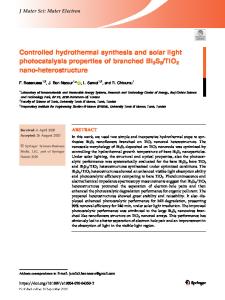Controllable hydrothermal synthesis of single-phase brookite TiO 2 photocatalyst
- PDF / 1,672,364 Bytes
- 10 Pages / 595.276 x 790.866 pts Page_size
- 93 Downloads / 365 Views
Controllable hydrothermal synthesis of single‑phase brookite TiO2 photocatalyst Yunling Zou1 · Yan Li1 · Xiaoxue Lian1 · Yao Xie1 · Xinyuan Song1 · Mengmeng Wang1 · Zhenyu Tian1 Received: 20 May 2020 / Accepted: 7 July 2020 © Springer-Verlag GmbH Germany, part of Springer Nature 2020
Abstract Pure brookite TiO2 with unique structure and property has demonstrated to be an interesting candidate in photocatalytic applications in recent years. In this study, single-phase brookite TiO2 was controllable synthesized via hydrothermal method using titanium chloride ( TiCl4), sodium lactate and urea as starting materials. The structure and morphology of as-synthesized samples were characterized by various techniques, such as X-ray powder diffraction (XRD), Raman spectroscopy, scanning electron microscopy (SEM), and transmission electron microscopy (TEM). The band gap value of as-synthesized samples was calculated by ultraviolet–visible (UV–vis) spectroscopy. Experimental results showed that the co-existence of sodium lactate and urea contributed to the formation of single-phase brookite T iO2. The amounts of sodium lactate and urea had significant effects on the structure and morphology of as-synthesized samples. Sodium lactate acted as a key complexant, and the concentration of urea determined the crystalline structure of as-synthesized samples. Single-phase brookite T iO2 was obtained when the amount of sodium lactate and urea was not less than 2.0 mL and 3.0 g, respectively. As the amount of sodium lactate or urea increases, the morphology of as-synthesized brookite TiO2 changes from quasi-spherical structures to rod-like structures. This study might be useful for understanding how the pure structure of brookite T iO2 is formed under given conditions and furtherly overcoming the difficulties of the preparation of pure brookite TiO2 with high purity and large specific surface area, which limits its applications in the field of photocatalysis. Graphic abstract
Keywords TiO2 · Brookite · Hydrothermal method · Sodium lactate · Formation Extended author information available on the last page of the article
13
Vol.:(0123456789)
618
Page 2 of 10
1 Introduction Titanium dioxide ( TiO2) has been considered as one of the most promising material and widely studied during the past decades due to its advantages (e.g. low cost, easy availability, high photocatalytic activity, and high chemical stability) and significant applications for solar cells [1, 2], electrochromic devices [3], sensors [4], photocatalyst agents [5–8]. It is worth mentioning that the potential applications of T iO2 for photocatalysis are probably the most important for future human development, since T iO2 might be used to solve (at least in part) three out of 10 of humanity’s top problems, i.e., energy, environment, and water [8]. Especially, the applications of T iO2 photocatalytic materials in H2 evolution from water and carbon dioxide ( CO2) reduction to produce valuable hydrocarbons (e.g., methane, methanol, etc.) have attracte
Data Loading...











